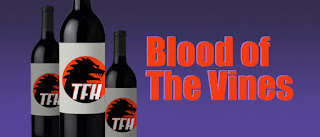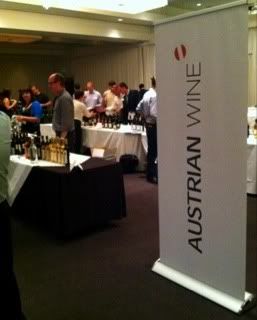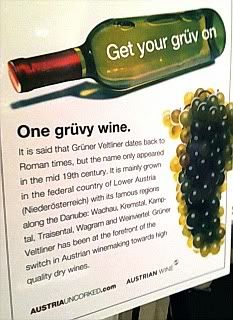The
Now And Zin Wine Country series continues with wine from the state of Washington. The overview of Washington wine’s historical perspective and the tasting notes of the wine sampled will come later.
I had the good fortune to chat by phone with the gentleman who agreed to supply the samples,
Bob Betz, of
Betz Family Winery. The following is an edited version of that conversation.
Betz Family Winery makes a limited amount of high-quality wine using fruit from neighboring vineyards in the Columbia Valley AVA. Betz describes his focus: “It’s all red - we don’t make any whites - and they are Bordeaux varieties and Rhone varieties. We have Cabernet Sauvignon, Merlot and Petit Verdot. And from the Rhone side of it, we make three different Syrahs that are all single-site Syrahs, and a southern Rhone blend that is Grenache-dominant. We blend Cabernets from Red Mountain, the west end of the Yakima Valley and the Horse Heaven Hills area along the Columbia River.”
Is Grenache widely planted in Washington? “No, it’s not,” Betz says, “but we’ve been making it for ten vintages. There was Grenache planted in the ‘50s, and in the ‘70s and ‘80s we were making rosé out of it; it was probably the best rosé in the country, with fabulous color and density and a crisp edge. Well, we learned a lot about making red wine from it, and I am a Southern Rhone nut. We blend in Syrah, Mourvedre, Cinsault and Counoise with it.”
Betz confesses, “I used to whimsically say that all wine would be red if it could, and while the majority of the wine I drink is red, give me a good bottle of Gruner Veltliner or Riesling or Chardonnay or Sauvignon Blanc. We started with all red, and never say never, but right now it’s all red.”
His love of Gru-Vee led to a bit of a oenological experiment on his property. “We planted 150 Gruner Veltliner vines right in front of the winery, but we have yet to make a wine from them,” say Betz. “The acid is so, so powerful that it’s not gonna happen.” Knowing how sommeliers love acidity, I suggested he make a lot just for them. “No, this is even too much for them,” he says. “We make about 20 gallons of juice every year and we have to dump it. 1.2, 1.3 grams, whew, it’s heavy stuff. Since we had no on-site vineyards, I just wanted to show people who visit that wine is a part of the earth. You don’t just turn a spigot and get wine. This vineyard is there to remind people where it comes from.”
I have been told that Washington Syrahs are great. “Yes,” he exclaims. “What we appreciate up here is the cooler growing season, especially once we hit post-véraison, [the onset of ripening] where our daytime temperatures are not so high, our nighttime temperatures are pretty low.”
Betz harvests mainly in September, but with Cabernet Sauvignon and Syrah, he may let the grapes hang on the vine a bit longer. “There’s not a lot of photosynthetic potential left in late October to early November here in the Columbia Valley, but we see a little increase in sugar accumulation, so we like to let them hang longer when we can. Both of these varieties seem to like that lingering development.
“Two of our three Syrahs are from pretty cool sites. One is from Red Mountain, a warm site, one is from the far west end of the Yakima Valley where it cools down pretty dramatically from mid-September, and then one right in between, the coolest of the sites at much higher altitude.”
I asked Betz if he thinks there is a single grape the Washington wine industry can hang its hat on. “No” was the quick answer. “Just about the time I get all wrapped up in Washington Riesling, or Chardonnay, or Syrah or Cabernet, I taste something really compelling and realize we’re doing a better job at deciding site/variety marriages than we were even ten years ago. There are sites where great Riesling is being grown, some warm sites where Cabernet Sauvignon comes from, and Syrah from both types of sites.”
Since a little history is always part of tasting wine from one of the American states, I asked Betz to encapsulate Washington wine history. “
Vinifera grapes [wine grapes of European origin] were planted in Washington back in the 1800s,” he says, “but our real history starts about 1950 or so when two wine companies decided they had had enough of loganberry and olallieberry and currant wines, and decided to give
vinifera grapes a try. Eventually the two companies merged and became Chateau Ste. Michelle. In the mid-1960s Ste. Michelle and Columbia Winery began popping
vinifera into the ground.”
Betz has been in the wine business a long time, and he spent a significant part of that time in the service of Chateau Ste. Michelle. Betz says, “Having been there for 28 years, I have a great deal of respect for what they do and how they do it. Making four thousand cases of wine is one thing, making four million is... wow, I’m in awe.”
“A guy named
Walter Clore was at Washington State University, and he is really the father of Washington wine, but Ste. Michelle’s influence on Washington wine cannot be overstated. I don’t say that as an ex-employee, I say it as a competitor. We wouldn’t be here without them.”
He took a few seconds to muse about his time making Betz Family wine. “This is our 17th vintage in the Columbia Valley. We had the first winery here that was built from the ground up, specifically to be a winery. People made wine in garages before that.”
Betz is selling the winery, and he makes it sound like he’s okay with that. “I’ll be released from day to day operations, so someone else will worry about forklift fuel and insurance policies. I’ll get to focus on winemaking.” In other words, Betz is not in the market for a rocking chair.
I hope to post about specific Betz Family wines sometime next week.
Follow Randy Fuller on Twitter














 As is the case at wine tasting events where there is a proliferation of one particular type of wine, I experienced palate fatigue and the Gruner Veltliners all started to taste the same. I've experienced the same thing at events that were heavy on Pinot Noir, Tempranillo and Albarino. Mixing it up made for a good palate cleanser. I'd taste whites for a while, then reds, then back to whites. I even went across the property and sampled a few Ribera Tempranillos at another event going on at the same time. As good as those Spanish wines were, I didn't stay long. I couldn't wait to get back to Austria.
As is the case at wine tasting events where there is a proliferation of one particular type of wine, I experienced palate fatigue and the Gruner Veltliners all started to taste the same. I've experienced the same thing at events that were heavy on Pinot Noir, Tempranillo and Albarino. Mixing it up made for a good palate cleanser. I'd taste whites for a while, then reds, then back to whites. I even went across the property and sampled a few Ribera Tempranillos at another event going on at the same time. As good as those Spanish wines were, I didn't stay long. I couldn't wait to get back to Austria. As I mentioned earlier, the wines of
As I mentioned earlier, the wines of 